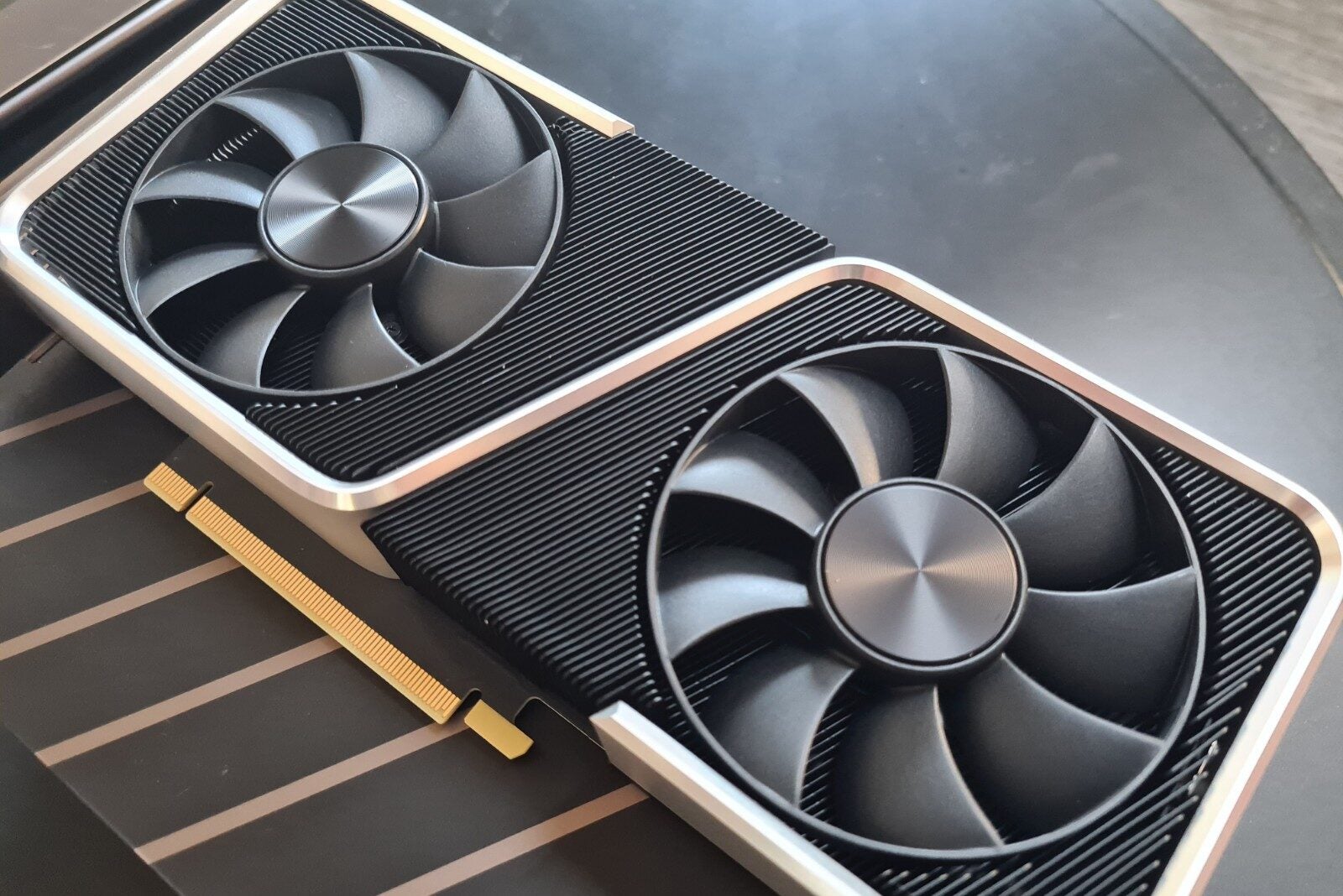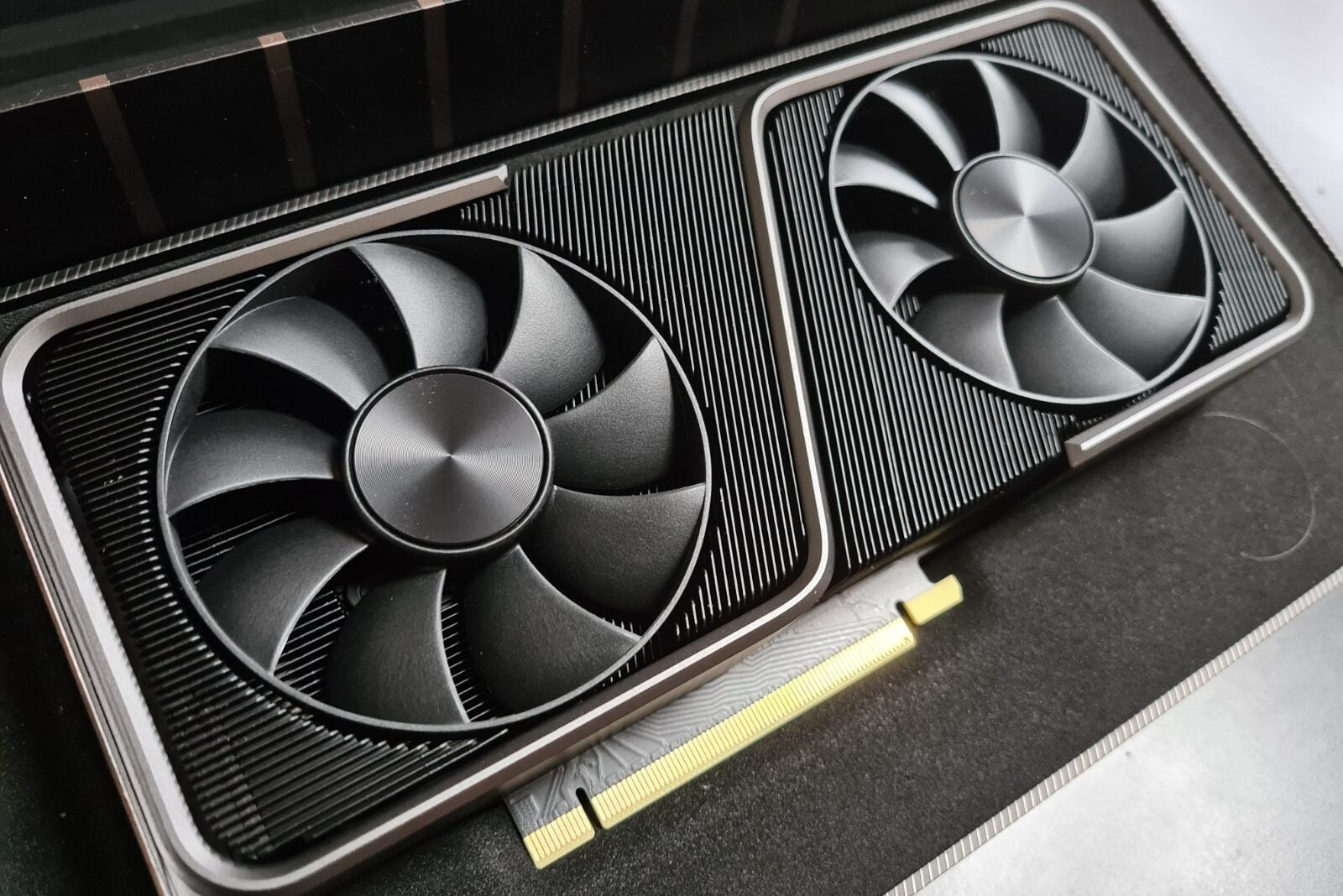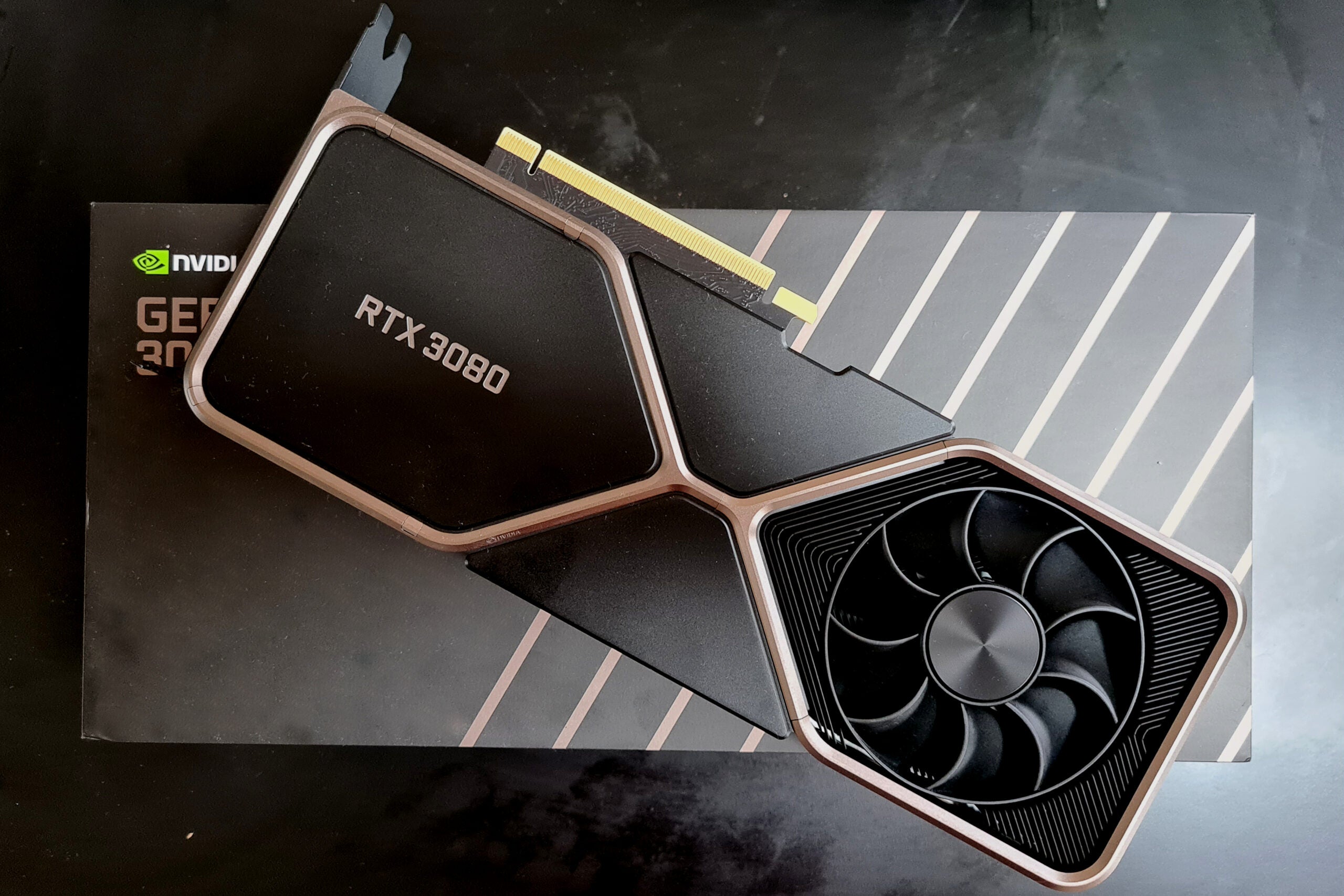Nvidia RTX 3080 Ti Review
A super-powerful graphics card for 4K gaming
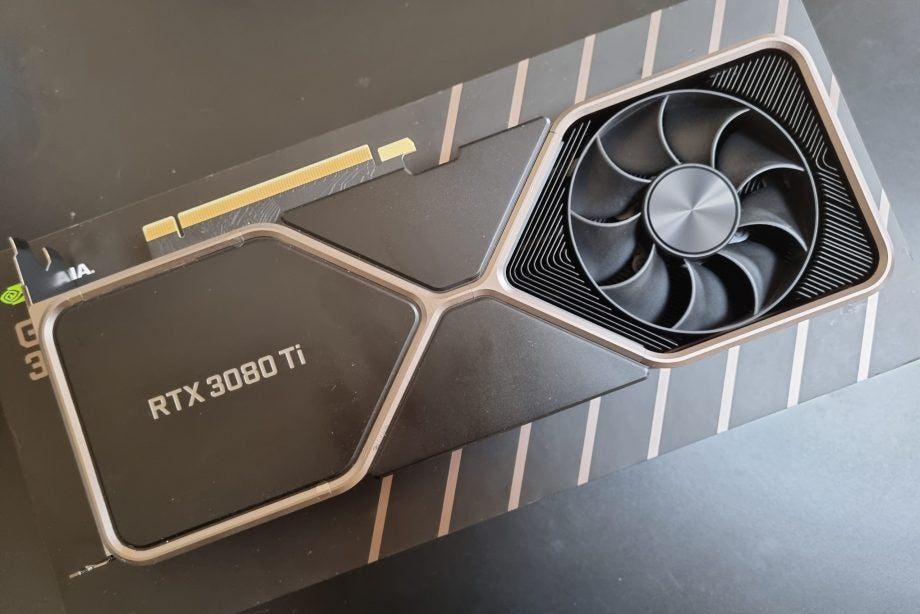

Verdict
The Nvidia RTX 3080 Ti is a powerhouse graphics card that delivers an excellent 4K ray tracing performance. If you can afford its steep up-front cost then it’s an excellent choice for any hardcore gamer looking for top-of-the-line performance. However, the gains you get compared to the base RTX 3080, which costs a lot less, make it a hard sell for gamers who don’t need the best performance possible in 4K.
Pros
- Excellent performance in 4K
- Ray tracing support
- Future-proofed connectivity
Cons
- The performance gains you get don’t fully justify how much more expensive it is over the regular RTX 3080
Availability
- UKRRP: £1049
- USARRP: $1199
Key Features
- Supports ray tracingThe card supports ray tracing lighting effects on compatible games
- HDMI 2.1 offers future-proof connectivityThe HDMI 2.1 input means the card is able to play games at 120Hz in 4K resolutions, when connected to compatible TV or monitor
- Powerful enough for 4K gamingThe RTX 3080 Ti is the second-most powerful consumer graphics card in Nvidia’s library. It’s more than powerful enough to play games in 4K
Introduction
The Nvidia RTX 3080 Ti is the latest GPU being pitched to hardcore gamers looking for THE best graphics possible by tech powerhouse Nvidia.
If this sounds familiar, it should. It’s the same pitch Nvidia made for its top-dog RTX 3090 when it launched in 2020. AMD’s flagship RX 6900 XT also targets the same $1119/£1099 section of the market.
On paper, this makes it an expensive luxury, especially when you consider the fact the regular RTX 3080 costs a far more affordable $699.
But after a week benchmarking the card in Trusted Labs test rig, I can confirm the RTX 3080 Ti is a very capable card that feels more like a slightly downgraded RTX 3090 than a souped-up RTX 3080. Make no mistake, if you can get your hands on one, the 3080 Ti is a worthwhile investment for any gamer looking to enjoy top-end ray tracing gameplay.
However, I’d still recommend most gamers, who don’t have expensive 4K gaming monitors or TVs with HDMI 2.1, to invest in a cheaper GPU such as the RTX 3070, RTX 3060 Ti or AMD RX 6700 XT. These offer more than enough power for 1080p or 1440p gaming and retail for a fraction of the price. And if none of these sound like the right fit, then you can see a curated pick of the best graphics cards we’ve tested in this handy guide.
Specs and design
- The RTX 3080 Ti is built on Nvidia’s Ampere architecture
- It has a similar design to other Nvidia cards
- Specs-wise, it’s more like a tweaked RTX 3090 than an upgraded 3080
From a design perspective the RTX 3080 Ti Founders Edition I tested is similar to most of its other 30-series siblings that have passed through Trusted Labs over the past couple of years.
It has a near-identical design and dual-axial cooling system. Dual-cooling fans are found on the top and bottom of the card’s left and right sides, with the main heatsink sitting between them. The card also uses the same custom 12-pin PCIe connector as its other 30-series siblings, which means you’ll need to use the bundled adapter to connect the card to older PSUs (power supplies).
The RTX 3080 Ti is built on Nvidia’s Ampere architecture, which launched last year alongside the first-gen RYX 3070, RTX 3080 and RTX 3090.
Ampere is seriously impressive and brings with it a wealth of key benefits for PC gamers. These include support for ray tracing games using Nvidia’s 3rd-generation tensor cores, DLSS and the inclusion of an HDMI 2.1 port.
Ray tracing is an awesome graphics technology featured on most modern triple-A games including Cyberpunk 2077. It’s a clever solution that lets games render near-photorealistic lighting effects and real-time shadows and reflections. It’s a key feature on most modern GPUs and consoles, including the PS5 and Xbox Series X/S.
The only downside to ray tracing is that the technology is very taxing on the GPU, and can sees significant drops to frame rates. This is where Nvidia DLSS steps in.
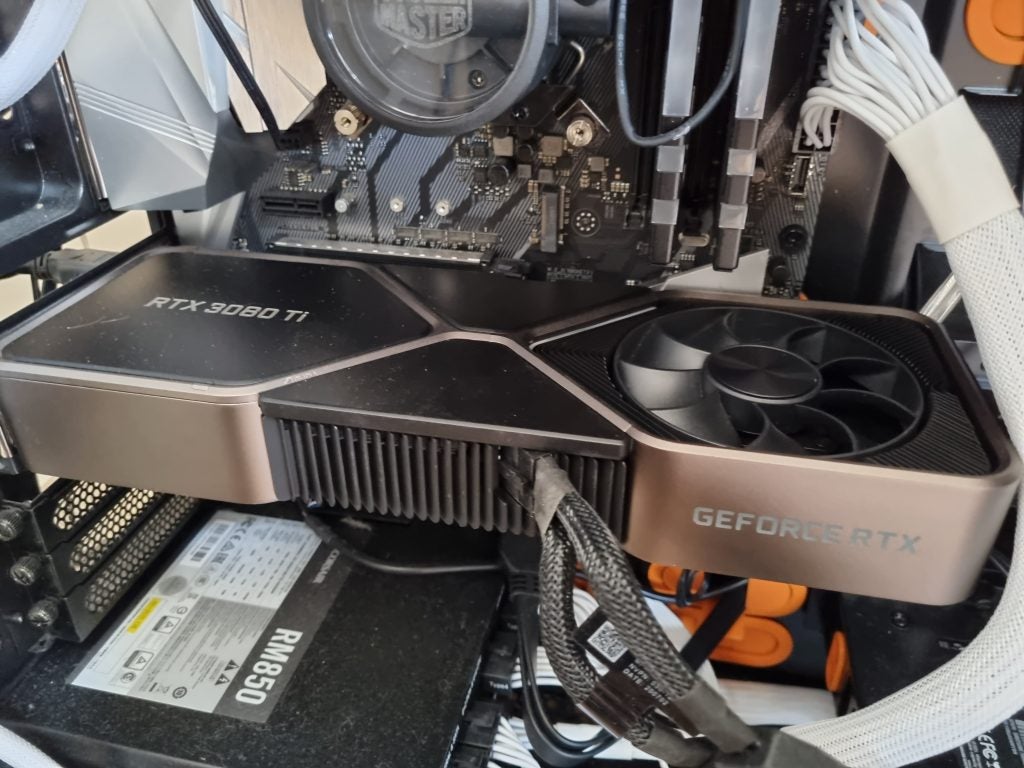
DLSS (Deep Learning Super Sampling) is an Nvidia RTX-specific feature that uses artificial intelligence to improve a GPU’s performance when running demanding processes. In the past it’s been a key reason I’ve recommended RTX cards over AMD’ latest GPUs, as without it most games won’t run over 60fps with ray tracing on.
However, this could change in the near future, as AMD has finally confirmed its rival FidelityFX Super Resolution software will be made available to the public on 22 June 2021. I’m excited to see how it compares to DLSS when the service becomes available, since this has been a key omission keeping its current gen’ RDNA 2 cards from competing with Nvidia’s Ampere.
HDMI 2.1 is a cutting-edge input that facilitates key features such as better HDR performance (high dynamic range), increased memory bandwidth and, most important, 120Hz/4K gaming.
So far you may justifiably be struggling to figure out what’s the main difference between the RTX 3080 Ti and other Nvidia Ampere-based graphics cards. The answer is actually pretty simple: specs. Although the cards share the same architecture, the 3080 Ti’s spec sheet includes a few key upgrades on the base RTX 3080 and is a full-fat generational leap on the older RTX 2080 Ti.
For starters, the RTX 3080 Ti has 2GB more GDDR6x memory than the regular RTX 3080. GDDR6x is one of the most expensive and top-performing types of video memory used in consumer graphics cards. Its key benefit is that it can facilitate significantly faster data transfer speeds than the base GDDR6 seen in cheaper graphics cards.
Next-gen performance has also been given a boost, featuring more tensor cores (the bits that run DLSS) and RT cores (the bits that handle ray tracing) than the base RTX 3080. The only downside is that the card has a higher 350W TGP, which means you’ll need a very high-capacity PSU to run it effectively, especially if you plan to overclock.
You can see a breakdown of the 3080 Ti’s core specs compared to the competition in the table below.
| Card | Price | VRAM | Core clock speed | Boost clock speed | Tensor Cores | RT Cores | RDNA Compute Units | TGP |
| Nvidia RTX 3090 | $1499 | 24GB GDDR6x | 1395 MHz | 1695 MHz | 328 | 82 | NA | 350W |
| Nvidia RTX 3080 Ti | $1199 | 12GB GDDR6x | 1365 MHz | 1665 MHz | 320 | 80 | NA | 350W |
| AMD RX6900 XT | $999 | 16GB GDDR6 | 1825 MHz | 2250 MHz | NA | NA | 80 | 300W |
| Nvidia RTX 3080 | $699 | 10GB GDDR6x | 1440 MHz | 1710 MHz | 272 | 68 | NA | 320W |
| AMD RX 6800 XT | $649 | 16GB GDDR6 | 1825 MHz | 2250 MHz | NA | NA | 72 | 300W |
| Nvidia RTX 3070 | $499 | 8GB GDDR6 | 1500 MHz | 1730 MHz | 184 | 46 | NA | 220W |
| AMD RX 6800 | $579 | 16GB GDDR6 | 1700 MHz | 2105 MHz | NA | NA | 60 | 250W |
| AMD RX 6700 XT | $479 | 12GB GDDR6 | 2424 MHz | 2581 MHz | NA | NA | 40 | 230W |
| Nvidia RTX 3060 Ti | $399 | 8GB GDDR6 | 1410 MHz | 1665 MHz | 152 | 38 | NA | 200W |
Benchmarks and performance
- Capable of running games at 60fps in 4K with ray tracing activated
- DLSS helps to boost the performance
To test the Nvidia RTX 3080 Ti, I ran the card through a variety of synthetic benchmarks and in-game tests using a rig with the below specs.
Test rig specs:
- Asus ROG Strix Z370-E Gaming (LGA1151)
- Intel Core i9-9900KF
- 16GB DDR4 RAM
- Samsung SSD 860 EVO 500GB SATA SSD
- Corsair RM750X PSU
- MasterLiquid Pro 280 cooler
Each test saw the games run with their graphical settings maxed out in 1080p, 1440p and 4K resolutions. On titles without built-in benchmarks, we recorded an average FPS running through pre-selected sections of the game.
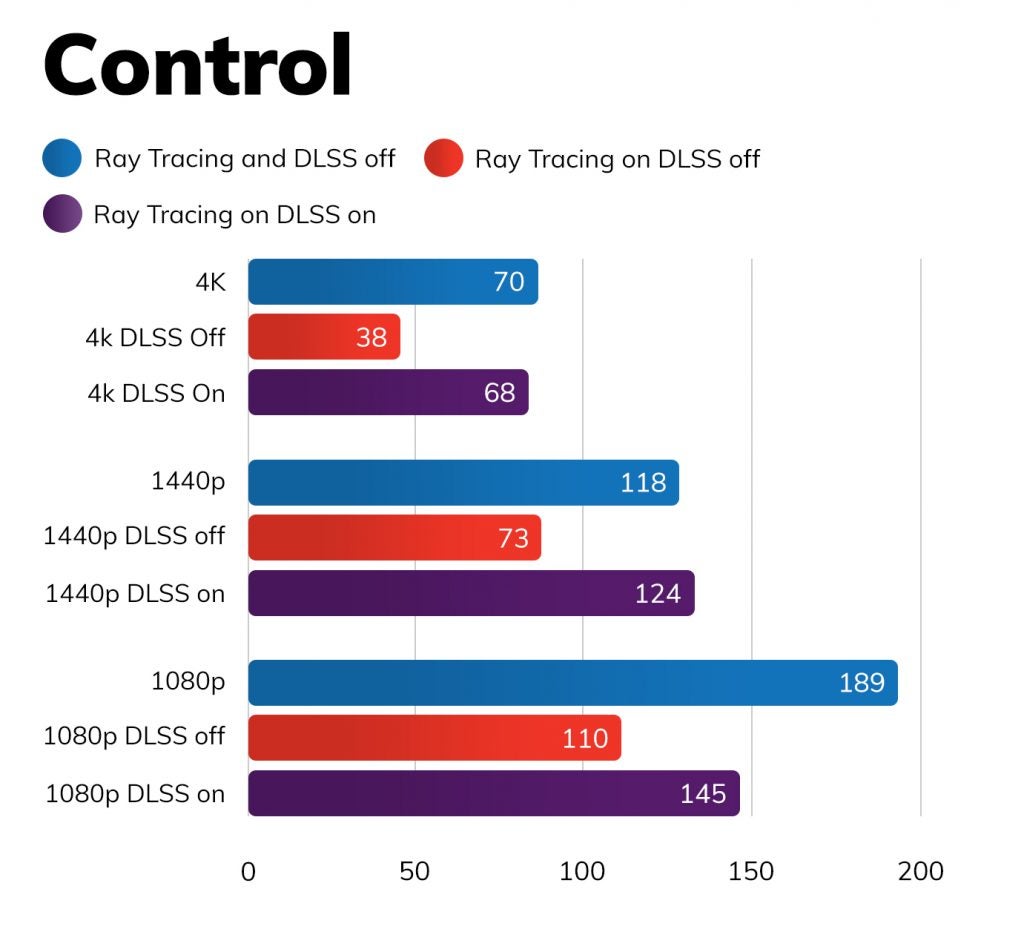
Control
Control was one of the first titles to be optimised to run ray tracing effects on Nvidia cards and is a great example how effective DLSS can be at mitigating against the damage it does to frame rates.
Here you can see the RTX 3080 Ti performed admirably, playing the game at playable frame rates with the graphics maxed and ray tracing and DLSS turned on. The only time it dropped below 60fps, which is considered the optimal point to comfortably play games, was when playing Control in 4K with ray tracing on and DLSS off.
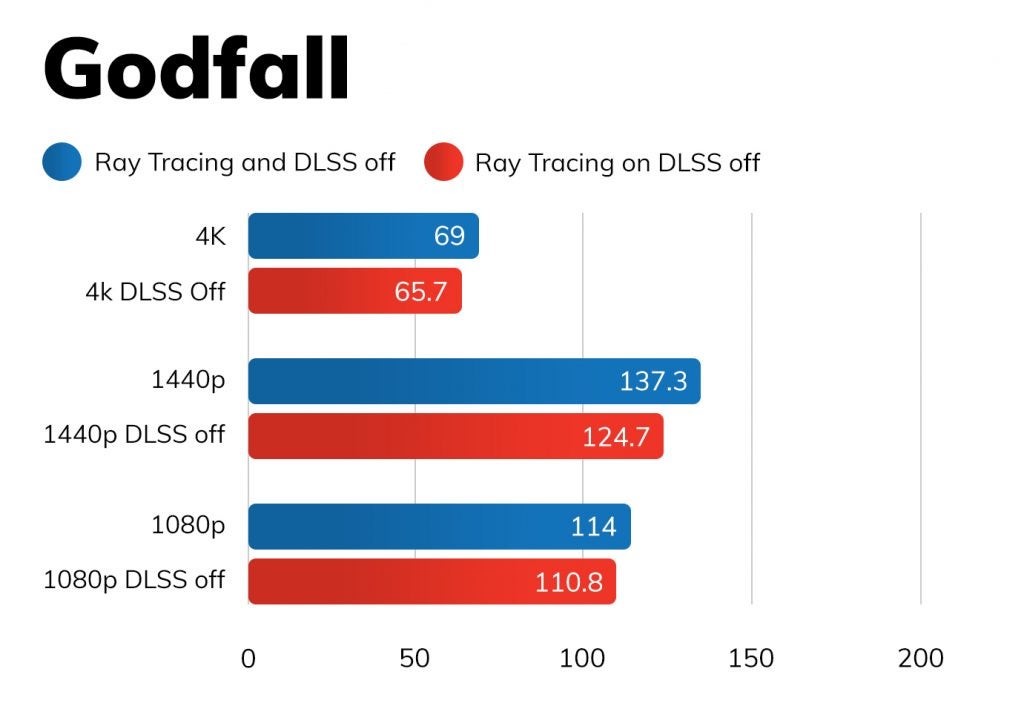
Godfall
Godfall is a large-scale open-world action RPG, full of reflective surfaces and advanced light effects. Unlike Control, it’s optimised to run ray tracing on AMD, rather than Nvidia graphics cards, which is the reason it doesn’t support DLSS at the moment. Here, the 3080 Ti once again proved capable of running the game at playable frame rates across every resolution.
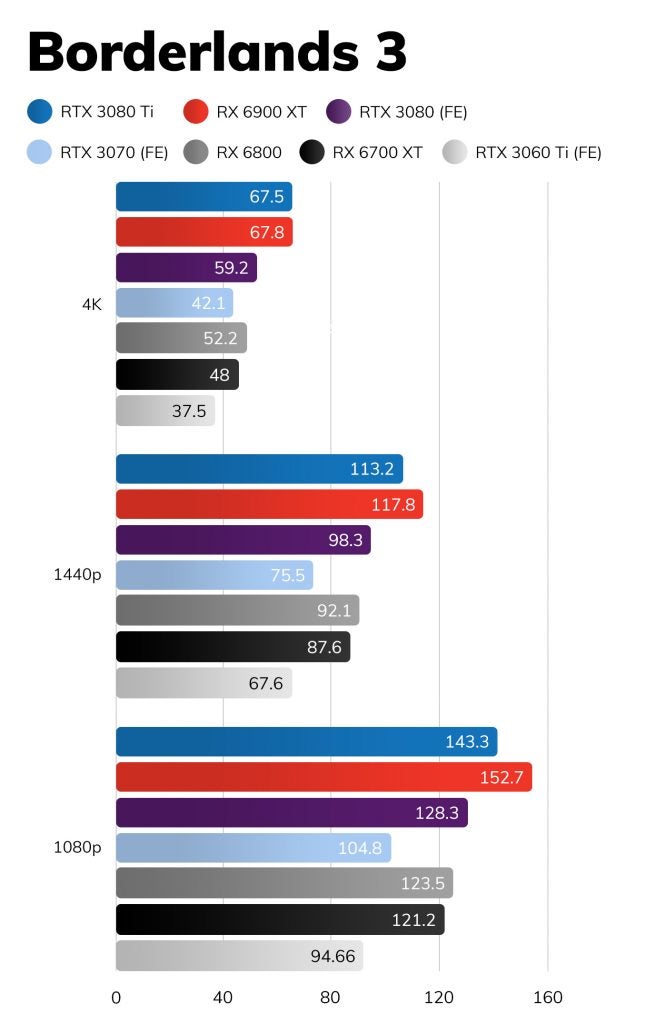
Borderlands 3
Borderlands 3 is a big open-world looter shooter full of sprawling maps, riddled with NPCs and complex physics. It doesn’t have ray tracing, but it’s a good metric to gauge how a GPU handles modern AAA shooters and multiplayer games.
Here, the RTX 3080 Ti managed to run the game with zero hassle, at post 60fps with the graphics settings maxed. However, the performance gains on the regular RTX 3080 weren’t quite as high as I’d have liked considering the disparity in price.
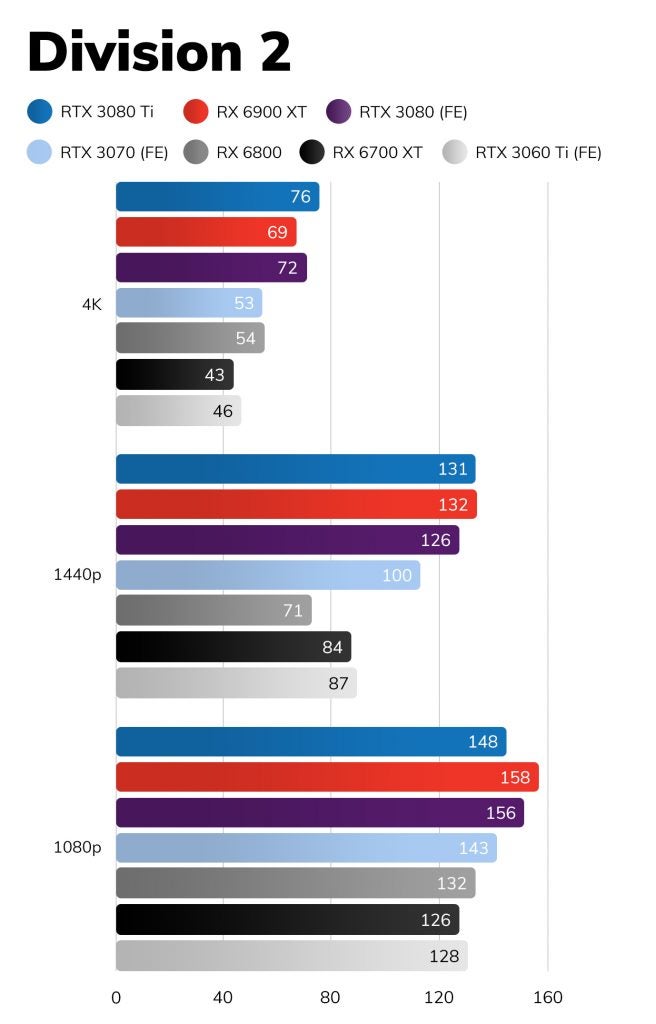
The Division 2
The Division 2 is one of Ubisoft’s largest live service games. It’s a multiplayer third-person shooter that takes place in a giant sprawling dystopian American cityscape. It isn’t the most demanding game on this list, but its internal benchmark is a good metric to judge how a GPU will run most live service games. Here, the 3080 Ti blitzed through the benchmark at every resolution.
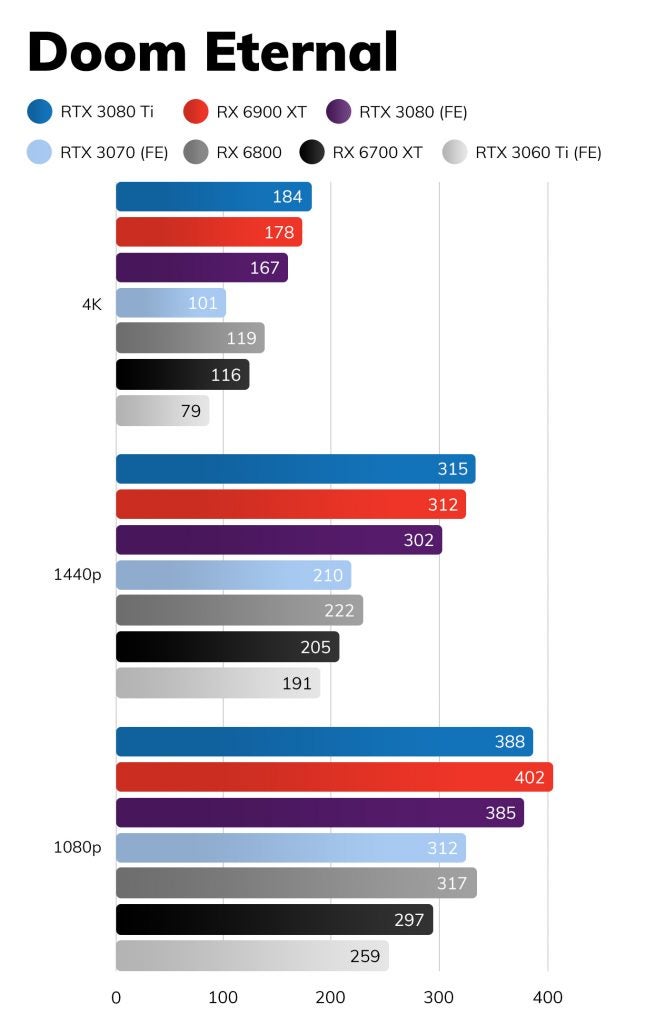
Doom Eternal
Doom Eternal is a gold standard to show how a well-optimised AAA shooter will run on a GPU. It’s also the only game in our benchmark suite to force you to run it using the Vulkan, rather than Direct X API.
Here, the RTX 3080 Ti once again ran the game at more than playable frame rates at every resolution with its graphics settings maxed. The game doesn’t have an internal benchmark, so we gauge performance by taking an average frame rate while playing through the open section of the first level.
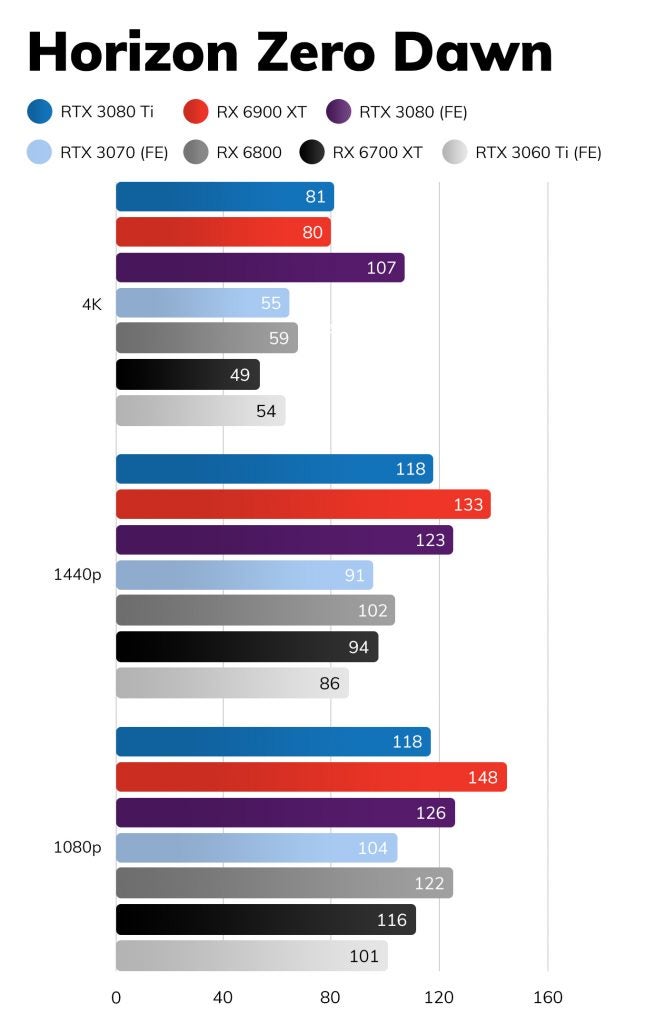
Horizon Zero Dawn
Horizon Zero Dawn is a beautiful open-world game full of advanced lighting, numerous moving parts and wonderfully detailed textures. The 3080 Ti played the game at over 60fps at every resolution, but we suffered stability issues throughout testing.
This is probably due to the pre-release drivers we used while reviewing it, and likely a key reason why it didn’t beat the performance of the base RTX 3080. We’ll update this review with final benchmark scores when we get our hands on the 3080 Ti’s consumer release drivers.
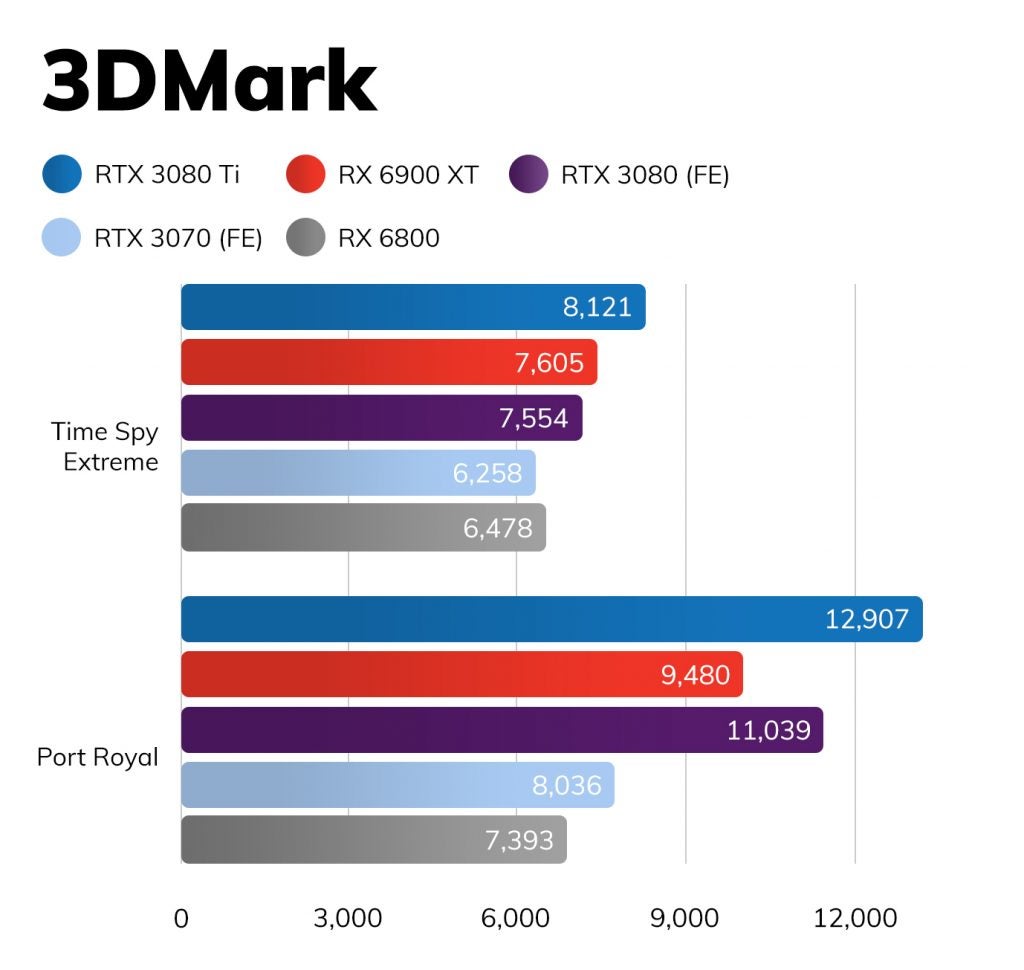
3DMark
3DMark is a suite of synthetic benchmarks designed to offer a general gauge of how powerful a GPU is. Each test focuses on a different aspect of a GPUs performance. The Time Spy Extreme benchmark we use gauges DirectX 12 performance. DirectX 12 is the API used by most modern games, so it’s a good way to judge how a GPU will run games in general.
Port Royal is a synthetic test designed to see how a GPU handles ray tracing. In both tests a higher score is better. The 3080 Ti absolutely blasted through both benchmarks, easily beating the RTX 3080 and its closest AMD rival, the RX 6900 XT.
Power consumption, thermals and overclocking
- The RTX 3080 Ti requires a lot of power to run
- It doesn’t leave a lot of room for overclocking
Nvidia’s Ti graphics cards are traditionally monster-truck components: loud, powerful and completely over-the-top beasts that require a lot of fuel to run. This remains the case with the 3080 Ti.
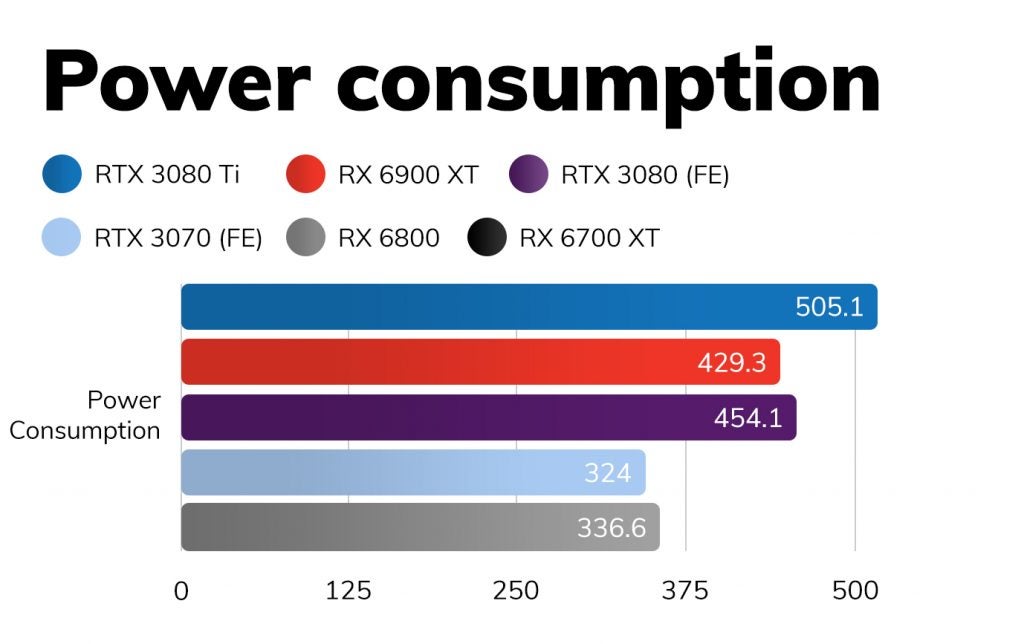
The 505.1W peak system draw I detected running Time Spy Extreme makes it a full 50W more demanding than the base RTX 3080, meaning you’ll definitely want to invest in a top-end PSU when planning a build with the new Ti. It also ran fairly hot, hitting a peak temperature of around 82ºC running the same benchmark. This is just 8ºC below the 90ºC threshold where GPUs start to struggle.
As a result, the 3080 Ti isn’t very overclockable. Doing a rough-and-ready overclock by looping the Time Spy Stress test while boosting the GPU using MSI Afterburner, I was only able to get a stable 160MHz clock and 80MHz memory overclock. After that, the system repeatedly started crashing.
Conclusion
The Nvidia RTX 3080 Ti is a powerhouse graphics card that delivers excellent 4K ray tracing performance. If you can afford its steep up-front cost, it’s an excellent choice for any hardcore gamer looking for top-of-the-line performance.
However, the gains you get compared to the base RTX 3080, which is a lot more affordable, make it a hard sell for gamers who don’t need the best performance possible in 4K. Gamers yet to do the jump to 4K will also be better off saving their cash and opting for a cheaper card, such as the 1440p-focused RTX 3070, or 1080p-focused RTX 3060 Ti, which are both very accomplished cGPUs in their own right.
With AMD’s answer to DLSS coming in the near future, the RX 6900 XT could also soon become a compelling option, with it offering similar performance at a near-identical price.
Best Offers
Should you buy it?
You want to play games with ray tracing on in 4K
Featuring next-generation hardware, an HDMI 2.1 input and the performance savings of DLSS, the RTX 3080 Ti is one of two cards that can reliably play all games in 4K at over 60fps with ray tracing on.
You’re yet to do the jump to 4K
If you’re still gaming on a 1440p or 1080p monitor, then there’s little reason to invest in such a powerful GPU. The base RTX 3080 is radically cheaper, but even then we’d recommend people opt for a cheaper card, such as the RTX 3070 or RTX 3060 Ti.
Verdict
The Nvidia RTX 3080 Ti is one of the most powerful graphics cards I’ve tested in quite some time, offering stellar 4K performance across the board, even with ray tracing graphics settings on. But its price makes it a very expensive luxury, with better value found elsewhere.
FAQs
The RTX 3080 Ti has slightly lower specs than the RTX 3090. The biggest cut has been to its VRAM – a spec that informs how well a GPU loads and runs programs.
The RTX 3080 Ti does support ray tracing gaming on compatible titles. It also supports Nvidia’s DLSS tech, which helps alleviate the stress that ray tracing puts on a card.
The RTX 3080 Ti can play most AAA games in 4K at over 60fps.

